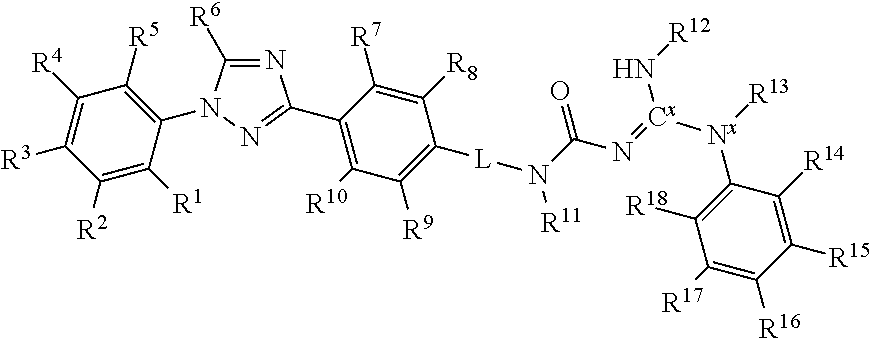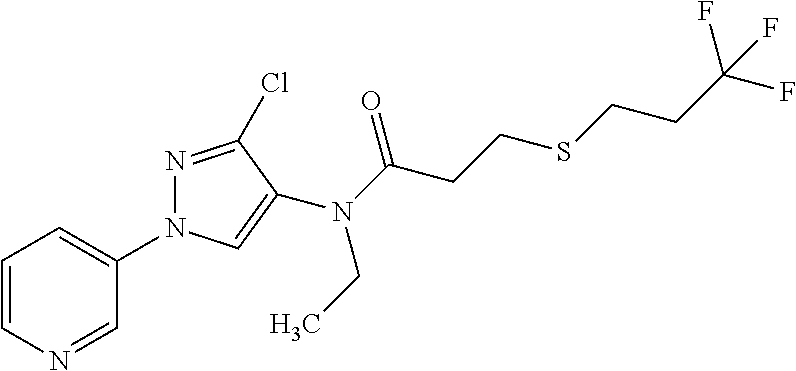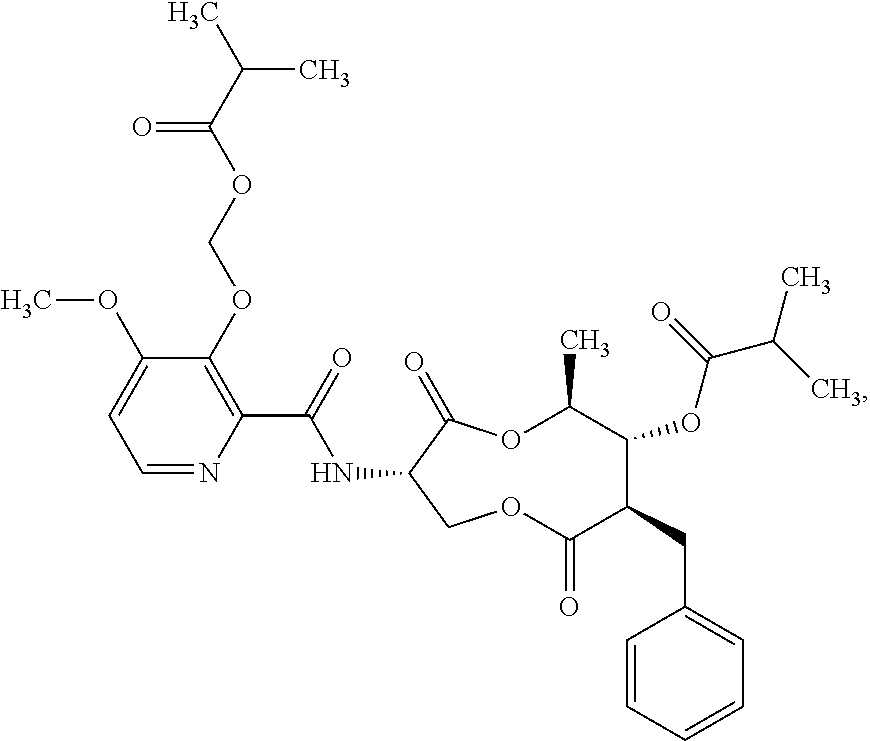Molecules having pesticidal utility, and intermediates, compositions, and processes, related thereto
a technology of pesticidal utility and molecules, applied in the direction of antiparasitic agents, biocides, drug compositions, etc., can solve the problems of destroying more than 40% of all food production, prone to loss, and often one of the most insidious and costly problems
- Summary
- Abstract
- Description
- Claims
- Application Information
AI Technical Summary
Benefits of technology
Problems solved by technology
Method used
Image
Examples
example 1
Preparation of (1E)-1-[amino(anilino)methylene]-3-[4-[1-[4-(trifluoromethoxy)phenyl]-1H-1,2,4-triazol-3-yl]phenyl]urea (F4)
[0174]
[0175]A stirred solution of 4-(1-(4-(trifluoromethoxy)phenyl)-1H-1,2,4-triazol-3-yl)benzoyl azide (0.25 g, 0.698 mmol) in toluene (12 mL) was heated to 110° C. for 3 hours. The reaction mixture was cooled to room temperature. The reaction mixture was then cooled to 0° C. and 1-phenylguanidine (0.113 g, 0.837 mmol) and trimethylamine (0.290 mL, 2.09 mmol) dissolved in 1,2-dichloroethane (3 mL) were added dropwise. The reaction mixture was allowed to warm to room temperature and stir for 24 hours. The resultant solid was collected by filtration, washed with isopropanol, and dried. The title compound was obtained as an off-white solid (0.220 g, 63%).
[0176]The following compounds were prepared in like manner to the procedure outlined in Example 1:
(1E)-1-[Amino-(2-phenylanilino)methylene]-3-[4-[1-[4-(trifluoromethoxy)phenyl]-1H-1,2,4-triazol-3-yl]phenyl]urea (F...
example 2
Preparation of (1E)-1-[amino-(2,6-dimethylanilino)methylene]-3-[4-[1-[4-(trifluoromethoxy)phenyl]-1H-1,2,4-triazol-3-yl]phenyl]urea (F11)
[0186]
[0187]To (Z)-((N-(2,6-dimethylphenyl)-N′-((4-(1-(4-(trifluoromethoxy)phenyl)-1H-1,2,4-triazol-3-yl)phenyl)carbamoyl)carbamimidoyl)thio)methyl isobutyrate (0.124 g, 0.203 mmol) in methanol (5 mL) was added ammonia (7 N in methanol, 0.500 mL). The reaction mixture was stirred at room temperature for 16 hours. The reaction mixture was filtered and the filtrate was concentrated. Purification of the residue by flash column chromatography using 0-100% ethyl acetate / hexanes as eluent, provided the title compound (0.029 g, 29%).
example 3
General Procedure for the Preparation of N1-Phenylethane-1,2-Diamines
[0188]
[0189]The N1-phenylethane-1,2-diamines used to prepare molecules of formula one may be prepared in like manner to the procedures outlined in Motoyoshiya, 3., et al. Tetrahedron (2011), 67, 6927-6933.
N1-(4-Chloro-2-methylphenyl)ethane-1,2-diamine (C1)
[0190]
N1-(5-Fluoro-2-methylphenyl)ethane-1,2-diamine (C2)
[0191]
N1-(2-Ethylphenyl)ethane-1,2-diamine (C3)
[0192]
N1-(2,4-Dimethylphenyl)ethane-1,2-diamine (C4)
[0193]
N1-Phenylethane-1,2-diamine (C5)
[0194]
N1-Mesitylethane-1,2-diamine (C6)
[0195]
N1-(2-Methoxyphenyl)ethane-1,2-diamine (C7)
[0196]
N1-(2-(Trifluoromethoxy)phenyl)ethane-1,2-diamine (C8)
[0197]
N1-(3-Methoxyphenyl)ethane-1,2-diamine (C9)
[0198]
N1-(4-Methoxyphenyl)ethane-1,2-diamine (C10)
[0199]
PUM
 Login to View More
Login to View More Abstract
Description
Claims
Application Information
 Login to View More
Login to View More - R&D
- Intellectual Property
- Life Sciences
- Materials
- Tech Scout
- Unparalleled Data Quality
- Higher Quality Content
- 60% Fewer Hallucinations
Browse by: Latest US Patents, China's latest patents, Technical Efficacy Thesaurus, Application Domain, Technology Topic, Popular Technical Reports.
© 2025 PatSnap. All rights reserved.Legal|Privacy policy|Modern Slavery Act Transparency Statement|Sitemap|About US| Contact US: help@patsnap.com



